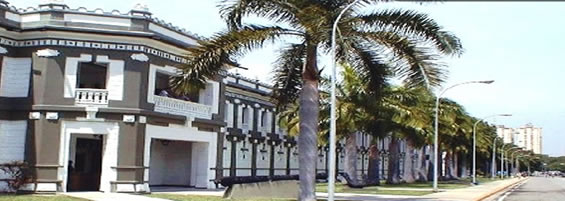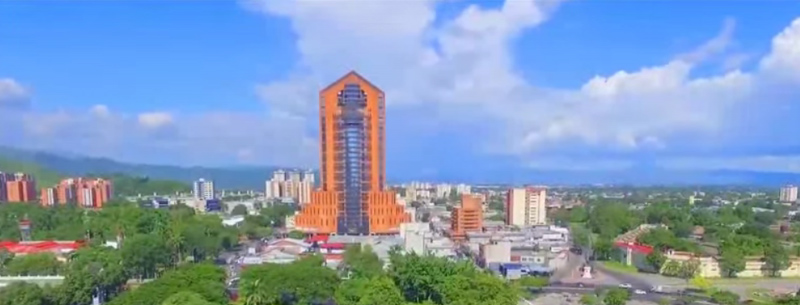Maracay Venezuela Travel Guide
This beautiful city is located in Aragua State, in the central region of the country, about 100 kilometers west of Caracas. It is also known as the “Ciudad Jardin” (garden city), bordered on the north by the Caribbean Sea, on the south by the Guarico state, on the east by the Distrito Federal and Miranda state, and on the west by the Carabobo state.

Maracay, the Garden City of Venezuela is located at the foot of the mountains to the coast. It is a very nice city full of gardens and trees in its streets and avenues. The entrance to the city was guarded by a jaguar made of bronze with the following inscription: “Maracay is a crossroads of all roads and the rose of the winds open to all wills”.
This city is the cradle of Venezuelan aviation, both the civil and military aviation, here was born the first Venezuelan airline called Aeropostal. The city is an important cultural center because of the museums and the important architectural icons it preserves, for example as La Maestranza César Girón, the Bolivar Plaza, the largest in the country, the Government Palace of Aragua State, and the Sindoni tower, the tallest building in the interior of the country.
City of Maracay
Maracay, also known as the Garden City is located in the political and administrative center region and is the capital of Aragua state and the Municipality of Girardot. It is located in the coastal mountains, between the Aragua valley and the shores of the Tacarigua or Valencia lake, approximately, at an altitude of 445 meters above sea level. This city was the birthplace of several heroes of Venezuelan independence.
The city began to be inhabited in the century XVII, but it was officially declared as the population on March 5, 1701, at that time it was erected as the vice-parish of the church of “San Jose de Maracay”.
Between 1908 and 1935, during the dictatorship of General Juan V. Gomez, it was the political capital of Venezuela, in this epoch, the city acquired the nickname “the Garden City”, it became the military city of Venezuela and the cradle of the aviation in the country. They were also built during this year’s several recreation, infrastructure, and military buildings.
It is the interior city in Venezuela which has the biggest number of museums and the biggest number of water fountains. Comprises the municipalities of Girardot, Mario Briceño Iragorry, Francisco Linares Alcántara, José Angel Lamas, Santiago Mariño, Sucre, and Libertador. It is the fourth most populated city in Venezuela.
Best of Maracay
Maracay is a very warm city that has a lot to offer to the people who visits it, here we have a list of some of the main tourist attraction in the city:
Plaza Bolivar
This famous place is located between the avenues of Miranda and Bolivar. Plaza Bolivar is the largest plaza in Venezuela.
Maestranza Cesar Giron
It is one of the most important bullfighting places in Venezuela and it was inaugurated on January 20, 1933.
Cathedral of Maracay
It is located in front of the Girardot Plaza and was built between the seventeenth and eighteenth centuries, in spite of having experimented several restorations it preserves its original colonial style.
San Jacinto park
This park is a vast area of recreation and leisure for the people living in Maracay, is located between Bolivar and Constitution Avenues.
Plaza Girardot
This plaza was designed by the famous architect Fruto Vivas, it won the National Award for Architecture.
Torre Sindoni
The “Torre Sindoni” is a skyscraper inaugurated in 1999, it’s located between the avenues Bolivar and Miranda.
Escuela Básica
The basic school of the national force army is located in front of the Plaza Bolivar, its construction was part of a defense and security program that was intended to gather the military units existed in Maracay.
Getting to Maracay
Maracay city has a small airport that hosts flights from different cities near to it. Buses arrive and depart from the Terminal Maracay bus. The bus station of Maracay is very chaotic and produces lots of delays when it is wanted to travel to another city. If you use the Terminal, make sure to be there early because in some seasons the lines are very long.
Once you get to the city you’ll see that public service transportation is readily available, although a bit messy. If you take a taxi in the city make sure it is part of a transport company, be careful when loading the luggage in the vehicle, and try to not sit on the side of the vehicle’s wheels.
You will see many taxis in the city because this is the most popular business in Venezuela and it is also cheaper. Almost all the taxis have no taximeter, and therefore you must negotiate a price with the driver.
Maracay History
The land on which is today located Maracay was given in the sixteenth century to the famous Spanish conquer Sebastián Díaz de Alfaro, once he died, this important figure inherited his lands to his son Mateo. The initial population of this city was established in the Tapatapa and tucupi Valley, near to the Maracay riverbank. Many historians regard as the date of the foundation of Maracay on March 5, 1701, because on this day the Bishop Diego de Baños y Sotomayor founded a parish in the city.

By 1800 the city had a population greater than 7,000 people, at that time then anil was exported in large quantities to Europe, it was a plant used for dyeing fabrics. This plant was one of its main agricultural products and was one of the major incentives for the growth of the city. In this year that the geographer and naturalist Alexander von Humboldt Maracay visited and appreciated one of the most symbolic plants in the city, the Samán Güero.
The city has suffered several changes in its political and territorial administration, it has been a town of the Caracas province, then a city of the Aragua province, it was part of Guzman Blanco State, part of the Bolívar State, finally and definitively, the capital of Aragua State. In the same way, the city has participated in the emancipatory heroic deed remembering the facts happened in 1812 and 1813 that had as scenario the hacienda called “La Trinidad”, as well as the assault of The Cabrera in 1816 and the Maracay combat in 1818 where the revolutionary troops were defeated.
In the years of the government of General Juan Vicente Gómez this town was the object of a strong urban and economic transformation. By the 1950s they were created several industries, which played an important role in the industrialization of the city. During 1960, the city was the object of strong immigration and invasion movements.
